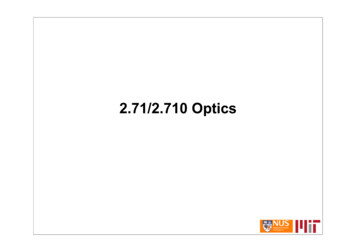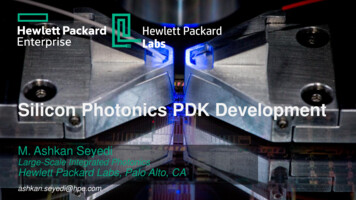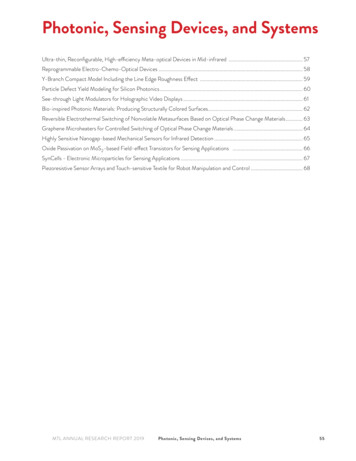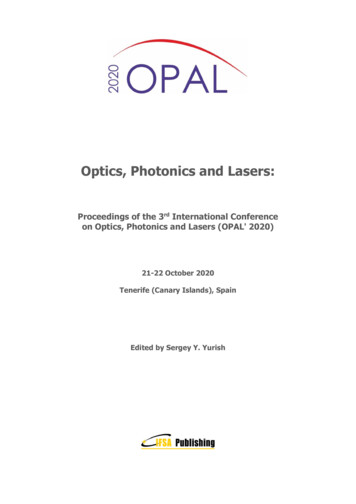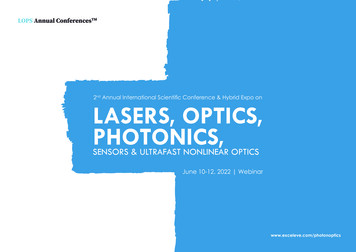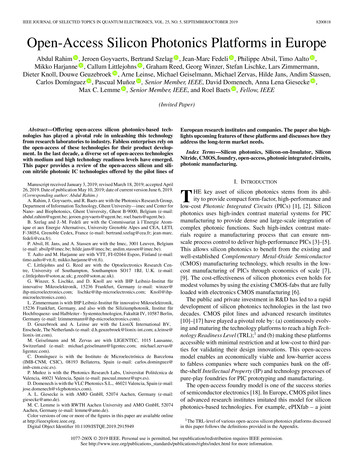
Transcription
FINAL REPORTOptics and Photonics Research forMontana Economic DevelopmentJoseph A. ShawDirector, Optical Technology CenterMontana State UniversityBozeman, MontanaCo-investigators: Paul Nugent (NWB Sensors, Inc.), Ross Snider (MSU), RickLawrence (MSU), Neda Nategh (MSU), Russell Barbour (Advanced MicrocavitySensors, LLC), Zeb Barber (MSU), Ed Dratz (MSU), Chris Arrasmith (Revibro Optics),Rufus Cone (MSU), Charles Thiel (MSU), Kevin Repasky (MSU), and Robert Walker(MSU).14 July 2017
Table of ContentsExecutive Summary1Subproject Reports1. Ultra-compact spectral imagers for precision agriculture, wildfire mapping,and natural resources102. High-performance, real-time image processing for hyperspectral imaging153. Remote Sensing Algorithms for Precision Agriculture194. Machine Vision Algorithms for Precision Agriculture215. Microcavity sensors for hyperspectral imaging236. Hyperspectral imaging for monitoring cell growth277. Translational research to commercialize micro-mirror technology298. Active waveguides and integrated optical circuits329. Optical parametric oscillator for tunable lasers4310. Nonlinear optical detection of surface contaminants45
Executive SummaryThe purpose of the Optics and Photonics Research for Montana Economic Development project was tofocus the impressive capabilities in optics and photonics research at Montana State University (MSU) onprojects with high promise to benefit Montana companies through technology development andcommercialization. This was a unique opportunity to focus the researchers’ efforts on problems that laymostly in the gap that routinely exists between academic research and commercial products. This gaparises because traditional research funding is rarely, if ever, available to refine basic research to a pointwhere it can be transitioned successfully to commercial products or services. Conversely, the companiesrarely, if ever, have sufficient means to ‘reach back’ far enough to pull the nascent results from a researchlab up to the company for refinement and commercialization. Therefore, this MREDI effort had rapid andsubstantial positive impact on the growth and strength of the Montana economy.The project included ten subprojects, with commercial potential ranging from immediate to longer-termpromise. This suite of activities was also designed to create new partnerships between optical remotesensing and agricultural researchers through several subprojects in precision agriculture. The project wasso designed to expand already strong optical remote sensing research expertise into new areas thatbenefit the broader Montana economy. Each subproject was led by a faculty member at MSU or by aMontana company president and included one or more Montana companies as direct or indirect partnerswhere the technology potentially could be commercialized (see Table 1).Table 1. Organization of the Optics and Photonics Research for Montana Economic Development project.Subproject1. Ultra-compact spectral imagers forprecision agriculture, wildfire mapping, andnatural resourcesLeaderDr. Joseph Shaw – MSUElectrical & ComputerEngineering (ECE)2. High-performance, real-time imageprocessing for hyperspectral imaging3. Remote sensing algorithms for precisionagriculture4. Machine Vision Algorithms for PrecisionAgriculture5. Microcavity sensors for hyperspectralimaging6. Hyperspectral imaging for monitoringcell growth7. Translational research to commercializemicro-mirror technology8. Active waveguides and integrated opticalcircuitsDr. Ross Snider – MSU ECE9. Optical parametric oscillator for tunablelasers10. Nonlinear optical detection of surfacecontaminantsDr. Rick Lawrence – MSULand Resources & Env. Sci.Dr. Neda Nategh – MSU ECEMontana BusinessesNWB Sensors, Inc.Freeman FarmsNugent FarmsMeridian Flying Svcs.Resonon, Inc.Flat Earth, Inc.Resonon, Inc.Resonon, Inc.NWB Sensors, Inc.Dr. Zeb Barber – MSUAdvanced MicrocavitySpectrum LabSensors, LLCDr. Ed Dratz – MSU Chemistry Resonon, Inc.& BiochemistryChris Arrasmith – RevibroRevibro OpticsOpticsDr. Rufus Cone and Dr.S2 Corp.Charles Thiel – MSU PhysicsAdvR, Inc.and Spectrum LabScientific MaterialsMontana InstrumentsDr. Kevin Repasky – MSU ECE AdvR, Inc.Dr. Rob Walker – MSUChemistry & BiochemistryAltos Photonics1
Long-term impactThe following specific goals were proposed to ensure long-term impact of this investment.1. Launch two new Montana optics and photonics companies that then existed on paper only(Advanced Microcavity Sensors, LLC, and Revibro Optics).2. Enable new products for eight Montana optics and photonics companies (Advanced MicrocavitySensors; Revibro Optics; Resonon, Inc.; NWB Sensors, Inc; AdvR, Inc; FLIR/Scientific Materials Corp.;S2 Corp; Montana Instruments).3. Create new collaborations that bring together optics and photonics researchers and companieswith Montana farmers for precision agriculture.4. Expand MSU optics and photonics research capabilities to help solve important Montanaproblems in agriculture, energy, natural resources, and health and biomedical sciences.5. Assist in recruiting and supporting top faculty and graduate students in optics and photonics,which in the long term will provide the largest return on investment by establishing stronger andbroader university research capacity and by training students in the advanced science andtechnology necessary to establish and grow optics and photonics companies.All subproject objectives or milestones were met, with a few small modifications made necessary by thenaturally unpredictable nature of research. In all cases, these modifications led to comparable results, andalmost always stronger results than anticipated in the original proposal.The long-term impact can be demonstrated numerous ways, but here we cite three examples. First, thiseffort led to several totally new collaborative relationships between Montana academic organizations andcompanies, especially in the field of precision agriculture. This is a collaboration that was literally createdby the Montana Research and Economic Development Initiative (MREDI), which will continue to grow andserve the diverse needs of both new and traditional segments of the Montana economy.Second, this effort created stronger partnerships between academic researchers and Montanacompanies, leading to lasting benefits through the creation of new commercial products and progresstoward future commercial products.A third example, and the final one given here, is the long-termimpact of training students in research with commercialization inmind. The MREDI project allowed us to more successfully recruitand retain excellent graduate students for university-industrycollaborative research. Our recent history shows clearly that thiskind of training produces graduates who start new hightechnology companies or become employees of and leaders insuch companies. This process, by which we have created morethan thirty optics and photonics companies in Montana, and therole of the MSU Optical Technology Center (OpTeC) in it, wasrecognized in September 2015 with an award of excellence intalent development presented by the University EconomicDevelopment Association (UEDA). Figure ES.1 is a photograph ofthis award being accepted in Anchorage, Alaska, by Dr. JosephShaw, MSU OpTeC Director and principal investigator of thisMREDI project.Figure ES.1 Dr. Joseph Shaw acceptingthe award of excellence in talentdevelopment from the UniversityEconomic Development Association(UEDA) at their annual meeting inAnchorage, Alaska, in Sept. 2015.2
New businessesA primary objective of this MREDI project was to launch two new companies, and by its conclusion thosetwo companies have grown and become solidified because of the MREDI activities and financial support,while a third company also was established partially as a result of this effort. Revibro Optics (Bozeman, MT) Microcavity Sensors, LLC (Bozeman, MT) Beartooth Scientific (Bozeman, MT)Commercial products or progress toward productsAnother key objective of this project was to create eight new products in Montana companies. This wasachieved, along with significant progress that could lead to even more products in coming years.Method of mapping weeds in grain fields using low-cost cameras – licensed to NWB Sensors, Inc.(Bozeman, MT) and in process of being commercialized.FPGA smart-camera system being commercialized at Flat Earth, Inc. (Bozeman, MT) for use by Resonon,Inc. (Bozeman, MT) in real-time hyperspectral image processing applications.Demonstrated feasibility and advantages of narrow-band spectral imaging for airborne weed mapping,which will result in an expanded market for the recently upgraded airborne hyperspectral imaging systemssold by Resonon, Inc.LCAM hyperspectral sensing technology being commercialized by Microcavity Sensors, LLC (Bozeman,MT).Hyperspectral imaging microscope with integrated microfluidic cell nutrient dosing system for Resonon,Inc. (Bozeman, MT).Adjustable-focus mirrors – Revibro Optics (Bozeman, MT)Spectroscopic testing of new laser materials produced by Scientific Materials Corp. (Bozeman, MT).Channel waveguides in LiNbO3 – AdvR, Inc. (Bozeman, MT)Lithium niobate crystal incorporating thulium ions for photonic signal processing, also with magnesiumions to increase the optical damage threshold – S2 Corp. (Bozeman, MT)Lithium niobate and lithium tantalite crystals – Scientific Materials Corp. (Bozeman, MT)Major progress toward commercially viable sub-micron periodically poled nano-photonic devices - AdvR,Inc. (Bozeman, MT)Nondestructive method of testing optical waveguides using frequency-chirped lasers – AdvR, Inc. andpossibly broader applications for Bridger Photonics, Inc. (Bozeman, MT).3
Major progress toward new lasers for gas sensing using nonlinear optical techniques – AdvR, Inc.(Bozeman, MT).Patents and other technology transferLicense to NWB Sensors, Inc. (Bozeman, MT): Mapping grain fields using low-cost, GPS-enabled camerasduring existing farm activitiesLicense to Revibro Optics (Bozeman, MT): Patent 7,494,233 - Off-axis variable focus and aberration controlmirrors and method.Patent for Liquid Crystal Arrayed Microcavity (LCAM) sensors: Patent WO 2016057125 A9 - MicrocavityArray for Spectral Imaging (2016).Patent for micro-machined focus-control mirrors licensed to Revibro OpticsProvisional patent application in preparation for enhanced thermal contact with insulating opticalmaterials to allow increased operating powers in a cryogenic environmentJobs createdThe Montana optics and photonics industry is growing at a high rate (estimated in surveys given by theMontana Photonics Industry Alliance to be approximately 8-13% annually in recent years) and during2015-2017 the MREDI funding has been a critical element helping to drive this growth (it is only oneelement, but a very important one). Therefore, although it is generally difficult to clearly identify whichjobs arose because of MREDI support, in some cases we can link new jobs to MREDI funding and resultsof this research. Those jobs, summarized below, are mostly occupied by holders of advanced science andengineering degrees. There were many more jobs created in this industry, but at least these are known tobe somehow related to the MREDI project.Company positions (10):1 engineer at Flat Earth, Inc.3 scientists/engineers at Advanced Microcavity Sensors, LLC2 permanent engineers and 1 temporary commercialization person at NWB Sensors, Inc.2 full-time and 1 part-time engineer at Revibro Optics, Inc.2 engineers/scientists at AdvR, Inc.University positions (48):20 graduate students22 undergrad students1 Research Engineer3 Research Scientists2 Postdoctoral scholarsGraduate degrees completed with MREDI supportOne of the most important products of university research is graduates who are trained with highlyspecialized skills. In optics and photonics research, the strongest training occurs in graduate school.4
Therefore, a very important product of the MREDI support is the following list of graduate students whoreceived either MS or PhD degrees during the two-year MREDI period (other students participated inMREDI research while pursuing degrees, but only those who finished during this period are listed).Briana JonesMSElectrical Engineering Repasky groupDec. 2015David RieslandMSOptics & PhotonicsShaw groupDec. 2016Monica WhitakerMSEESnider groupDec. 2016Aaron MarshMSPhysicsCone groupMay 2017Conner DackMSEESnider groupMay 2017Chat ChantjaroenPhDEngineering (ECE)Repasky groupMay 2017Cooper McCannPhDPhysicsRepasky groupMay 2017Christine GobroggePhDChemistryWalker groupMay 2017Michael RoddewigPhDEngineering (ECE)Shaw groupMay 2017New grant funding to MSU and industry ( 20.83M)The MREDI project not only focused some of our attention on technology commercializationopportunities, but also helped us continue to grow and diversify our research activities, as shown by thefollowing list of new grants and sales made possible in full or in part by the MREDI work. 80k NPS – Development and testing LIDAR to study insect responses to light and noise – awardedMay 2017 (Shaw) 98,800 USDA/NIFA - Creating an advanced, economical, environmentally friendly measurementof snow water equivalence using observed GPS signals beneath the snowpack 30,000 MT State Matching Funds Program – (NWB Sensors, Inc. – Bozeman, MT) 99,850 USDA/NIFA - Intelligent mapping of the farm using low-cost, GPS-enabled cameras duringexisting farm activities (NWB Sensors, Inc. – Bozeman, MT) 300k NIH/SBIR – Development of an open speech signal processing platform, R44 DC015443-01(Snider, SBIR Phase I with Flat Earth, Inc. – Bozeman, MT) 12.5k MT Ag Exp’t Station (Lawrence) 172k NSF – A biologically inspired algorithm to detect, segment and track moving objects withobserver motion” (Nategh) 75k NASA EPSCoR (Nategh) 77.7k Air Force STTR (Barber with Spectral Molecular Imaging, Inc., Beverly Hills, CA) 209k MBRCT (Barber with AMS, LLC) 150k NIH (Phase-1 SBIR with AMS, LLC) 750k NIH (Phase-2 SBIR with AMS, LLC) 129k MBRCT (Barber with AMS, LLC) 25k National Academy of Sciences (Dratz PhD student fellowship) 225k NSF – High-power laser compatible MEMS deformable mirrors for confocal and two-photonmicroscopy (Phase-1 SBIR to Revibro Optics) 40k commercial sales for newly founded Revibro Optics 60k S2 Corp. – Efficient photonic computational engine for selection and filtering (Barber) 4.5M ONR – Full-spectrum staring receiver (Barber) 800k S2 AFRL – Instantaneous wideband 10 GHz time difference of arrival (SBIR with S2 Corp) 50k NASA – Nanoscale poling and structuring in nonlinear optical materials (Himmer andNakagawa)5
500k NSF – Photonics enabled extreme bandwidth wireless communications receiver (Phase-IIBSBIR with S2 Corp.) 1M IARPA – Efficient, high-data-rate photonic computational engine for 2-D image processing(Babbitt with S2 Corp). 81k MBRCT – Internally cooled laser trapped particles for ultra-high sensitivity accelerometry 27k ONR – Functionalization of optically levitated particles 1.59M NSF – Development of a micropulse DIAL (MPD) testbed for sensing lower troposphericwater vapor profiles (Repasky). 363.5k ARO – Organic enrichment at aqueous interfaces: Cooperative adsorption and its role inatmospheric science (Walker). 426.2k NSF – Nonlinear optical studies of high temperature surface chemistry in energyconversion systems (Walker). 345k ONR – Operando optical studies of electrochemical oxidation and materials degradation inhigh temperature solid oxide fuel cells (Walker). 8.6M of related funding to S2 Corp. 50k of sales of new rare-earth-activated materials developed at Scientific Materials Corp. incollaboration with MSU.Pending grants ( 24.8M)The impact of the MREDI work will continue to grow in the future, as illustrated by the following list ofgrants that are pending as of the writing of this report. Some of these, such as the first one on the list, areproposals for direct follow-on work in areas where we did not previously have suitable experience. 200k USDA - Hyperspectral imaging: A Remote-Scouting IPM tool for Early Detection of HerbicideResistant Weed In-crop – Jha and Shaw, submitted May 2017 314.7k Industry - Hyperspectral Imaging and Spatial Learning for Produce Monitoring – Shaw andSheppard, submitted June 2017 20M NSF – CREWS: Convergent Research on Environmental Water – Multiple investigatorsthroughout the MUS with Shaw, to be submitted July 2017 188k NASA – Space debris identification and tracking system based on a real-time, adaptivemotion processing algorithm (Nategh) 2M NIH/SBIR – Development of an open speech signal processing platform, Phase-2 SBIR – FlatEarth, Inc. (Bozeman, MT) with Snider 1.25M USGS - Improved Biophysical and Geophysical Data Extraction Using Agnostic ImageAnalyses and Super Ensembles (Lawrence) 750k NSF (Phase-2 SBIR with AMS) 150k DARPA (Phase-1 SBIR with AMS) 1.8M NIH – Early detection of Alzheimer’s disease by combining blood-based assays withmolecular imaging (Dratz).6
Partnerships formed, strengthened, or expandedThrough working together, we formed stronger and expanded partnerships between MSU and thefollowing organizations. NWB Sensors, Inc. (Bozeman, MT)Freeman Farms (Fairfield, MT)Nugent Farms (Fairfield, MT)Quadrocopter, LLC (Columbia Falls, MT)Flat Earth, Inc. (Bozeman, MT)Advanced Microcavity Sensors, LLC (Bozeman, MT)Resonon, Inc. (Bozeman, MT)Revibro, Inc. (Bozeman, MT)AdvR, Inc. (Bozeman, MT)S2 Corp. (Bozeman, MT)Montana Instruments (Bozeman, MT)Scientific Materials Corp./FLIR (Bozeman, MT)University of CalgarySpectral Molecular Imaging Inc. (Beverly Hills, CA)Peer-reviewed journal publicationsAnother major output of all research programs is publication of results in the peer-reviewed literature.The following papers have been published or submitted during the MREDI period.M. R. Roddewig, F. R. Hauer, J. H. Churnside, P. E. Bigelow, and J. A. Shaw, “Airborne lidar detection andmapping of lake trout spawning sites in Yellowstone Lake,” Appl. Opt. (in review 5/17).M. R. Roddewig, J. H. Churnside, and J. A. Shaw, “Airborne lidar detection of an underwater thermalvents,” J. Appl. Rem. Sensing (in press 7/17).M. R. Roddewig, N. J. Pust, J. H. Churnside, and J. A. Shaw, “Dual-polarization airborne lidar for freshwaterfisheries management and research,” Opt. Eng. 56(3), 031221 (2017).M. Vollmer and J. A. Shaw, “Atmospheric optics in the near infrared,” Appl. Opt. 56(19), G145-G155 (2017).J. A. Shaw, “Inflight observations of Bottlinger’s rings,” Appl. Opt. 56(19), G113-G119 (2017).J. A. Shaw and M. Vollmer, “Blue sun glints on water viewed through a polarizer,” Appl. Opt. 56(19), G36G41 (2017).Z. W. Barber, C. Harrington, R. K. Mohan, T. Jackson, C. Stiffler, P. B. Sellin, and K. D. Merkel, “SpatialSpectral Holographic Real-Time Correlative Optical Processor with 100 Gb/s Throughput,” Applied Optics56(19), 5398-5406 (2017). doi:10.1364/AO.56.005398C. Stoltzfus, R. Barbour, D. Atherton, and Z. Barber, “Micro-Sized Tunable Liquid Crystal Optical Filters,”Optics Letters 42(11), 2090-2093 (2017). doi:10.1364/OL.42.0020907
R. E. Latterman, S. Birrell, P. A. Sullivan, and R. A. Walker, “Improved pulsed laser operation withengineered nanomaterials” ACS Applied Materials and Interfaces 8 (30) 19724-19731 (2016).C. A. Gobrogge, V. A. Kong and R. A. Walker, “Unusual Temperature Dependent Solvation and Partitioningin Phospholipid Membranes” J. Phys. Chem. B 120 (8) 1805-1812 (2016).S. M. Burrows, E. A. Gobrogge, L. Fu, K. A. Link, S. M. Elliott, H. F. Wang, and R. A. Walker “OCEANFILMS2: Representing co-adsorption of saccharides in marine films improves agreement of modelled andobserved marine aerosol chemistry” Geophys. Res. Lett. 143 (15) 8306-8313 (2016).C. A. Gobrogge, H. S. Blanchard, and R. A. Walker “Temperature Dependent Partitioning of Coumarin 152in Phosphatidylcholine Lipid Bilayers” J. Phys. Chem. B, 121 (16) 4061-4070 (2017).C. A. Gobrogge and R. A. Walker “Quantifying Solute Partitioning in Phosphatidylcholine Membranes”submitted to Analytical Chemistry.C. A. Gobrogge, V. A. Kong and R. A. Walker “Temperature Dependent Partitioning of C152 in BinaryPhosphatidylcholine Membranes and Mixed Phosphatidylcholine/Phosphatidylethanolamine Membranes” inrevision with J. Phys. Chem. A (invited for Veronica Vaida Festchrift).T. Lutz, L. Veissier, C. W. Thiel, P. J. T. Woodburn, R. L. Cone, P. E. Barclay, and W. Tittel, “Effects ofmechanical processing and annealing on optical coherence properties of Er3 :LiNbO3 powders,” Journalof Luminescence, In Press, available online (2017) doi: 10.1016/j.jlumin.2017.03.027.N. Sinclair, D. Oblak, C. W. Thiel, R. L. Cone, and W. Tittel, “Enhanced properties of a rare-earth-ion-dopedwaveguide at sub-Kelvin temperatures for quantum signal processing,” Physical Review Letters 118 (2017)100504.S. Welinski, C. W. Thiel, J. Dajczgewand, A. Ferrier, R. L. Cone, R. M. Macfarlane, T. Chanelière, A. LouchetChauvet, and P. Goldner, “Effects of disorder on optical and electron spin linewidths in Er3 ,Sc3 :Y2SiO5,”Optical Materials 63 (2017) 69.L. Veissier, C. W. Thiel, T. Lutz, P. E. Barclay, W. Tittel, and R. L. Cone, “Quadratic Zeeman effect and spinlattice relaxation of Tm3 :YAG at high magnetic fields,” Physical Review B 94 (2016) 205133.T. Lutz, L. Veissier, C. W. Thiel, P. J. T. Woodburn, R. L. Cone, P. E. Barclay, and W. Tittel, “Effects offabrication methods on spin relaxation and crystallite quality in Tm-doped Y3Al5O12 powders studiedusing spectral hole burning,” Science and Technology of Advanced Materials 17 (2016) 63.T. Böttger, C. W. Thiel, R. L. Cone, Y. Sun, and A. Faraon, “Optical spectroscopy and decoherence studiesof Yb3 :YAG at 968 nm,” Physical Review B 94 (2016) 045134.T. Lutz, L. Veissier, C. W. Thiel, R. L. Cone, P. E. Barclay, and W. Tittel, “Modification of phonon processesin nanostructured rare-earth-ion-doped crystals,” Physical Review A 94 (2016) 013801.L. Veissier, M. Falamarzi, T. Lutz, E. Saglamyurek, C. W. Thiel, R. L. Cone, and W. Tittel, “Opticaldecoherence and spectral diffusion in an erbium-doped silica glass fiber featuring long-lived spinsublevels,” Physical Review B 94 (2016) 195138.8
N. Kunkel, A. Ferrier, C. W. Thiel, M. O. Ramírez, L. E. Bausá, R. L. Cone, A. Ikesue, and P. Goldner, “Rareearth doped transparent ceramics for spectral filtering and quantum information processing,” APLMaterials 3 (2015) 096103.E. Saglamyurek, T. Lutz, L. Veissier, M. P. Hedges, C. W. Thiel, R. L. Cone, and W. Tittel, “Efficient and longlived Zeeman-sublevel atomic population storage in an erbium-doped glass fiber,” Physical Review B 92(2015) 241111(R).S. Spuler, K. Repasky, B. Morley, D. Moen, M. Hayman, A. Nehrir, “Field deployable diode laser baseddifferential absorption lidar for profiling water vapor,” Atmospheric Measurement Technology. 8, 10731087 (2015).T. N. Ashour, E. Dratz, S. Halonen, “Use of human induced pluripotent stem cell-derived neurons as amodel for Cerebral Toxoplamosis,” Microbes Infect. 18(7-8), 496-504 (2016).doi: 10.1016/j.micinf.2016.03.012. Epub 2016 Apr 12 PMID: 27083472N. Tanaka, E. Dratz, S. Halonen, S. “Use of human induced pluripotent stem cell-derived neurons as amodel for Cerebral Toxoplasmosis,” Microbes Infect, 18(7-8), 496-504 (2016).R. J. Usselman, C. Chavarriage, P. R. Castello, M. Procopio, M. Ritz, E. Dratz, D. J. Singel, C. F. Martino, “TheQuantum Biology of Reactive Oxygen Species Partitioning Impacts Cellular Bioenergetics,” Sci Rep.6:38543 (2016). doi: 10.1038/srep38543.C. McCann, K. S. Repasky, M. Morin, R. Lawrence, and S. Powell, “A novel histogram based unsupervisedclassification technique to determine natural classes from biophysically relevant fit parameters tohyperspectral data,” IEEE Journal of Selected Topics in Applied Earth Observations and Remote Sensing99:1-11 (2017).C. McCann, K. S. Repasky, M. Morin, R. Lawrence, and S. Powell, “Using Landsat surface reflectance(LaSRC) data as a reference target for multi-swath hyperspectral data collected over mixed agriculturalrangeland areas,” IEEE Transactions on Geoscience and Remote Sensing (in press).C. McCann, K. Repasky, R. Lawrence, and S. Powell, “Multi-Temporal Mesoscale RadiometricallyReferenced Hyperspectral Data of Mixed Agricultural and Grassland Regions for Vegetation HealthMonitoring,” ISPRS Journal of Photogrammetry and Remote Sensing (in review).M. Morin, R. Lawrence, K. Repasky, T. Sterling, C. McCann, and S. Powell, “Agreement analysis and spatialsensitivity of multispectral and hyperspectral sensors in detecting vegetation stress at managementscales,” Journal of Applied Remote Sensing (in review).Laffoon, Masters, Dratz, and Roberts, “Deep-proteomic screen of plasma proteins reveals biomarkers forAlzheimer’s disease that are dependent on sex and APOE genotype,” Alzheimer’s Research and Therapy(in review).Laffoon, Masters, Dratz, Roberts, “The Australian imaging, biomarker and lifestyle study: ApoE-all complexin the proteomic comparison of plasma HEPSEPH binding proteins from homozygous ApoE carriers,” tobe submitted in July 2017.9
Subproject 1: Ultra-compact spectral imagers for precision agriculture and mapping of wildfires andnatural resources (Joseph Shaw with NWB Sensors, Inc.). Development of ultra-compact imaging systemsfor weed mapping in precision agriculture, UAV mapping of wildfires, and a wide variety of ground-basedand airborne remote sensing. The sensor systems will be commercialized through NWB Sensors, Inc. andtested for precision agriculture at Montana farms in Fairfield, MT and Sidney, MT with Meridian FlyingServices from Sidney, MT.Milestonesa) September 30, 2015: Initial agricultural data collection completedb) December 31, 2015: Initial weed maps completec) June 30, 2016: Prepare a refined imaging system and application-specific algorithmd) December 31, 2016: Complete results of summer 2016 harvest experimente) June 30, 2017: Finish imaging system and algorithms and transfer to private partnerAccomplishmentsThe purpose of this subproject was to develop ultra-compact opticalimaging systems for remote sensing in important Montana applications.The primary focus was on mapping weeds during grain harvest, withsecondary areas of ultra-compact thermal imagers and compact lidarsystems for use in applications ranging from natural resource managementto ecological studies. All milestones were met, and along the way welearned that off-the-shelf action cameras could be used with machine-visionalgorithms to map weeds at harvest, with comparable performance to thatachieved with the visible-and-near-infrared camera systems we built in ourlab. For example, an off-the-shelf GoPro camera correctly detected weedsor lack of weeds 93% of the time relative to expert observers viewing thesame images. An off-the-shelf Garmin camera performed the same taskwith 97% accuracy relative to the same expert observers. In theseexperiments, the cameras were mounted in the cab of a combine andrecorded images during harvest on multiple Montana farms (Fig. 1.1). Thisweed-mapping method has been licensed to NWB Sensors, Inc. ofBozeman, MT, who are further refining it for commercial application. Anexample weed map from this method is shown in Fig. 1.2.Fig. 1.1 Custom and off-theshelf camera systems in acombine cab during harvest.Fig. 1.1 Custom and off-theshelf cameras mounted in acombine during harvest.Fig. 1.2 Weed map created from images obtained during harvest on a Montana grain farm.10
We also developed methods to provide quantitatively calibrate thermal images from ultra-compactimaging modules with rapidly increasing capabilities and falling costs. Their small size and low cost makethem extremely attractive for drone-based remote sensing and bring thermal imaging down to theconsumer market. However, they provide notoriously poor stability and accuracy, resulting in images thatare only qualitatively useful without our calibration methods. We have demonstrated that these modulescan be calibrated successfully, resulting in greatly increased stability and accuracy. For example,calibration of a FLIR Lepton module resulted in an RMS uncertainty of 1.57 W/(m2 sr) using our standardmicrobolometer calibration methods. Using an exponential-based algorithm that accounted fortemperature compensation vs time, the uncertainty was further reduced to 1.31 W/(m2 sr). This showsthat even ultra-low-cost IR imaging modules can be calibrated sufficiently for many quantitative remotesensing measurements. An example of these ultra-compact, low-cost imaging modules is the tiny chip onthe right-hand side of Fig. 1.3, which is a photograph of uncooled thermal infrared imagers we haveworked with at MSU since 2001. An example thermal image from this tiny module is shown in Fig. 1.4.Fig. 1.3 Uncooled thermal infrared imagers used in our labsince 2001. The current study uses the tiny imaging modulesitting in a plastic dish on the right-hand side.Fig. 1.4 Thermal image recorded with ultra-compactthermal imaging module, showing person, a distantbuilding, and clouds.The final technology we developed further in thissubproject was a compact airborne lidar system that can fly in a small, single-engine airplane for studiesof lake and river ecology. We refined the prototype system and used it to help map spawning locations ofinvasive lake trout that threaten the ecological balance in and around Yellowstone Lake, which has greatimplications for the Montana tourism and recreation economic segments. We also demonstrated that thissystem can provide useful measurements ranging from profiling of underwater thermal vents tomonitoring water quality through range-resolved measurements of water turbidity and planktondistributions. Figure 1.5 shows a photograph of this system mounted in the airplane and Fig. 1.6 is a timeheight plot of the signal from Yellowstone Lake, showing a dome-shaped bottom feature with underwaterthermal vents (seen
Assist in recruiting and supporting top faculty and graduate students in optics and photonics, . The long-term impact can be demonstrated numerous ways, but here we cite three examples. First, this . 98,800 USDA/NIFA - Creating an advanced, .

